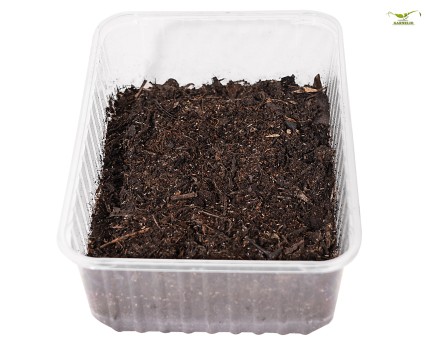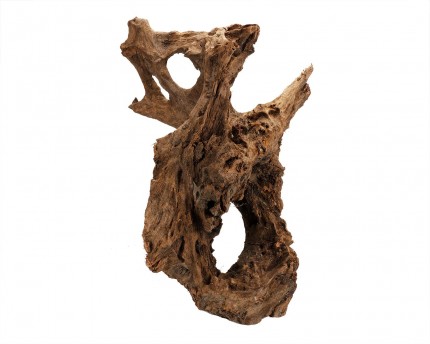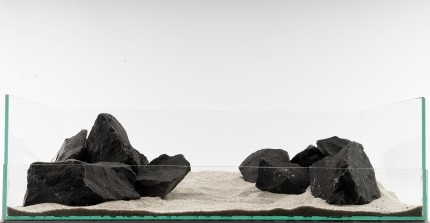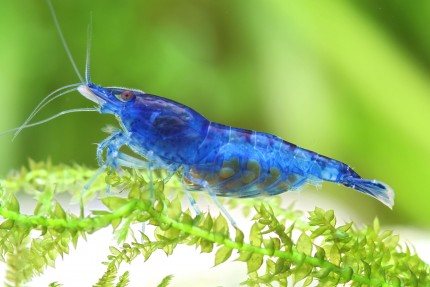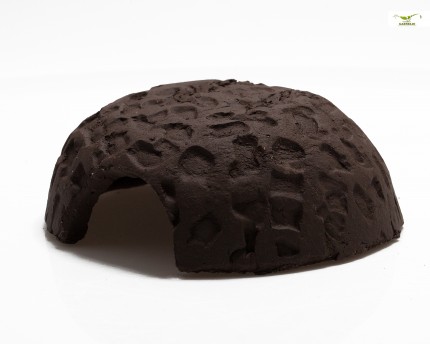- Item no: 1053
Fast delivery times
All products are in stock with us!14 years of breeding experience
Let our team of experts advise you!High customer satisfaction
from over 3,000 reviews "The peaceful and undemanding dwarf crab from the island of Java/Indonesia can already be kept and propagated in small wet terrariums. The two-colored vampire crab Geosesarma bicolor is a small land crab, which can be found in its habitat from time to time also on trees. The extremely attractively colored bicolor vampire crab is reddish-purple in base color, but half of the dorsal carapace is a bright yellow-green. The demarcation may be sharp or blurred. The Bicolored Vampire Crab reaches a dorsal carapace width of about 2.5 to 3 cm and thus remains rather small.
The bicolored vampire crab is omnivorous, but clearly prefers carnivorous foods, as do all other Geosesarmidae. Freeze-dried crustaceans such as Gammarus and insects such as grasshoppers or crickets are good foods, but so are raw unseasoned fish, fish food tablets, and crab foods for carnivorous species. Occasionally Geosesarma bicolor will also eat some vegetables, peeled fruit or greens. White isopods and springtails should not be missing in any crab terrarium, they not only take care of food remains, but are also a good source of live food.
The keeping temperature of Geosarma bicolor should be between 24-28 degrees. The bicolor vampire crab lives mainly on land. In the terrarium it needs a small water part or a 6-10 cm deep bathing bowl with fresh water and quite high humidity. Geosesarma bicolor do not belong in an aquarium at all. Peat, coco humus or bark mulch is recommended as substrate for keeping the Bicolor Vampire Crab, roots and plants are recommended for climbing. Make sure that the terrarium closes absolutely tight! The small armored knights are social group animals, therefore you should refrain from keeping them individually. A group of two females and one male can be kept already in small terrariums of 40 cm length.
Female bicolor vampire crabs incubate their 20 to 60 eggs under the U-shaped abdominal apron. The abdominal flap of the males is V-shaped. After a few weeks, fully developed juveniles hatch from the eggs and immediately begin foraging in the aquaterrarium. Unfortunately, the adults chase the offspring very strongly, if you want to grow the little ones safely, you should separate them.
Our food recommendation: Crabs in the wild tend to have a very varied diet. Most species are omnivores, and with the Natureholic Crab Feed Sticks we have taken this preference into account. They contain biologically balanced animal and vegetable components, which are also part of the natural food spectrum of omnivorous crabs in the field in such or such a similar way. The valuable ingredients of NatureHolic Crab Feed naturally support the molting, digestion, growth and reproduction of your crabs.
Our plant recommendation: For planting, use marsh plants, which are plants that are rooted in soil that is very wet or even submerged, but whose flowers and leaves are usually all or partially in the airspace and can be seen above the water surface. Thus, marsh plants are usually found on and in lakes and streams, but also on and in garden ponds or other bodies of water that provide them with a wet substrate, but still leave room for flowers and leaves to show to the outside.
Expert Tip: We recommend NatureHolic 3 Phase Liquid when keeping invertebrates. The care set offers the best all-round protection for your invertebrates. It ensures optimal conditions for successful breeding and keeping.
| Scientific name | Geosesarma bicolor Ng & Davie, 1995 |
| German Name: | Bicolor vampire crab |
| Difficulty level: | for beginners |
| Origin/Distribution: | Java/Indonesia |
| Coloration: | Base color reddish-purple, half of the dorsal carapace is a bright yellowish green |
| Age expectancy | 2-3 years |
| Parameters: | shallow bowl with fresh water, air temperature 24 to 28 °C |
| Tank size: | from 60 cm for a group of 5-6 animals, from 40 cm for 3 animals. Pay attention to excess of females! |
| Food | brown autumn leaves, frozen food, freeze-dried insects and crustaceans, fish meat, special food for carnivorous crabs, vegetables, green food, fruit |
| Reproduction | not difficult, fully developed young hatch. However, adults are cannibalistic |
| Behavior | peaceful, group animal |
| Socialization | Keep in species tank |
| Further information | Colorful jewels in the terrarium - land crabs of the genus Geosesarma, micro crabs, Limnopilos nayanetri - The smallest crab in the world!, Keeping mangrove crabs |
- Item no: 1053
- EAN No.: 4251932205056
Entdecke die Garnelio Welt!
Garnelio gehört zu den größten Onlineshops für wirbellose Aquarientiere weltweit.
Viele Artikel gibt es exklusiv nur bei uns im Shop.





















